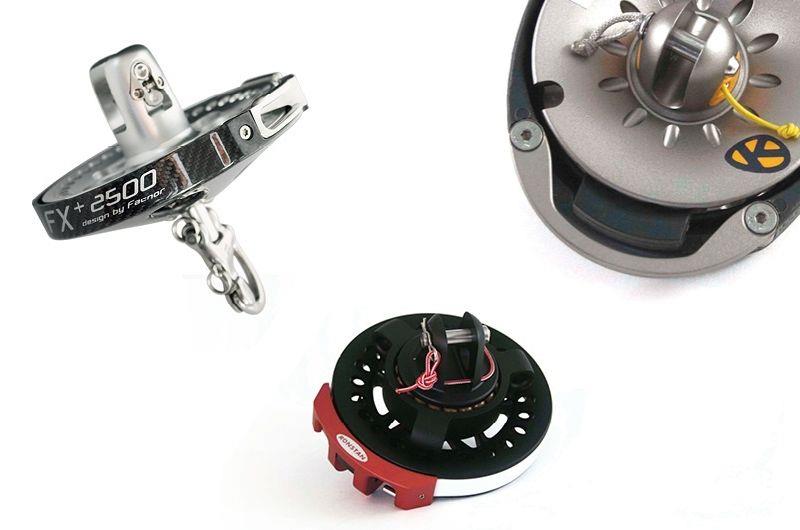
Choosing a Code 0 or Gennaker Furler
by Diego Sosa, Upffront 10 Sep 2018 04:00 PDT

Facnor, Ronstan and Karver Furling Drums © upffront.com
How do I choose the right code zero or gennaker furling unit for my boat? Data from eight well-known manufacturers is reviewed and conclusions drawn to help guide you to an appropriate unit for your needs.
A quick review of the available data will tell you that sizing the correct furling unit for your boat is NOT an exact science!
The correct method for specifying a unit is by the Safe Working Load (SWL) and this is the one consistently available piece of information, across all manufacturers. Unfortunately, few, if any, people really know the SWL of their forestay or their Code zero tack load...!?
However, do not despair. It is possible to generalise, based on boat size, to get a ballpark SWL and then consider several variables to guide your final decision.
First cut based on Boat size
Summarising the data manufacturers provides an initial guide to required SWL based on your boat size. See table below:
| Boat Size m (ft) | SWL (</kg) |
|---|
| 8 (26) | 750 |
| 10 (33) | 1000 |
| 12 (39) | 2000 |
| 14 (46) | 3000 |
| 18 (60) | 5000 |
| 21 (69) | 8000 |
| 26 (85) | 12000 |
As an example, if you have a 46ft boat you should be looking for a furling unit with a SWL of 2500-3000 kg, whilst a 50-53 ft boat might require something in the 4000 kg range.
Other Considerations
- Displacement and sail size
- If you have a particularly heavy displacement boat and/or particularly large and powerful sail, then you might consider a slightly larger unit
- If you have a multihull this will almost always push you into the next category up due to the increased stability and therefore, loads.
- Staysails
- Due to the significantly smaller sail areas relative to code zeros and gennakers, on the same boat, Staysail furlers can often be a size range
down.
- Do you have an existing sail / furling cable?
- If so, the thimble width on your furling cable is critical to the specification of the unit.
- Various jaw widths and pin sizes are available across the different unit manufacturers, but this will limit your choice to a few suitable units
- Please do not forget jaw depth i.e. the distance from the pin to the back of the jaw. It is by no means guaranteed that this distance is enough to accommodate your thimble/cable.
- Top-down or bottom-up
- Despite the obvious choice of whether to go for a dedicated top-down furling unit, Top-down furling has other consequences on unit size
- Loads are much smaller for top-down furling and therefore you should be able to go down a size
- However, cable sizes are always bigger in diameter relative to bottom-up cables. This drives bigger thimble widths which often forces you to buy a larger furing unit than is required on pure SWL requirements.
- Only a small number of manufacturers appear to have optimised their ranges for the specific needs of top-down furling.
- However, one good example is KZ Race Furlers from New Zealand where every unit is available with a range of jaw sizes - to allow a smaller SWL unit with a larger than normal jaw width to accommodate the larger thimble.
- But this flexibility does come at a premium price.
- Drum diameter
- If you have narrowed your selection down to a few possible options, drum diameter is another important consideration
- A bigger drum provides more torque / power which will be useful for a heavier, larger code zero
- A smaller drum delivers more speed - an essential component to successful top-down furling (N.B. the smaller the drum the more power and line speed you need to be able to generate from either your winches or your arms - depending on boat size!)
- Lock or no Lock
- Furling drum locks / ratchets are becoming increasingly popular, but they are by no means standard across the manufacturers.
- Code zero's and gennakers are always either fully furled or fully unfurled and historically people have been content to tie or cleat off the furling line when the sail is furled
- However, increasingly customers like the security of using a lock to prevent the accidental unfurl.
Finally, having considered all the factors above and you still have some options, weight is always a key decision criterion. This is no less important for cruising boats. Saving weight should be on your mind in every hardware and rigging choice made on your boat. Lowering the overall weight of your boat makes it stiffer and more powerful / responsive but also reduces the overall loads. This in turn, increases safety factors, reduces ware and ultimately increase the life of your hardware and rigging.
Summary
The following list is roughly in order of importance:
- Identify a suitable SWL range based on your boat size
- If you have a multihull - go one category up
- Is your displacement or sail particularly large/small which may influence the SWL above or below these average recommendations?
- If you have an existing cable - consider jaw width/depth and pin diameters
- If it's for top-down, you need to minimise SWL but consider all the other important criteria for effective furling and be prepared to accept the larger unit size
- Check your options on drum size and consider lock or no lock
- Finally choose the lightest one
If you would like more information on furling systems in general, please feel free to download our detailed "Furling System - Overview" document.